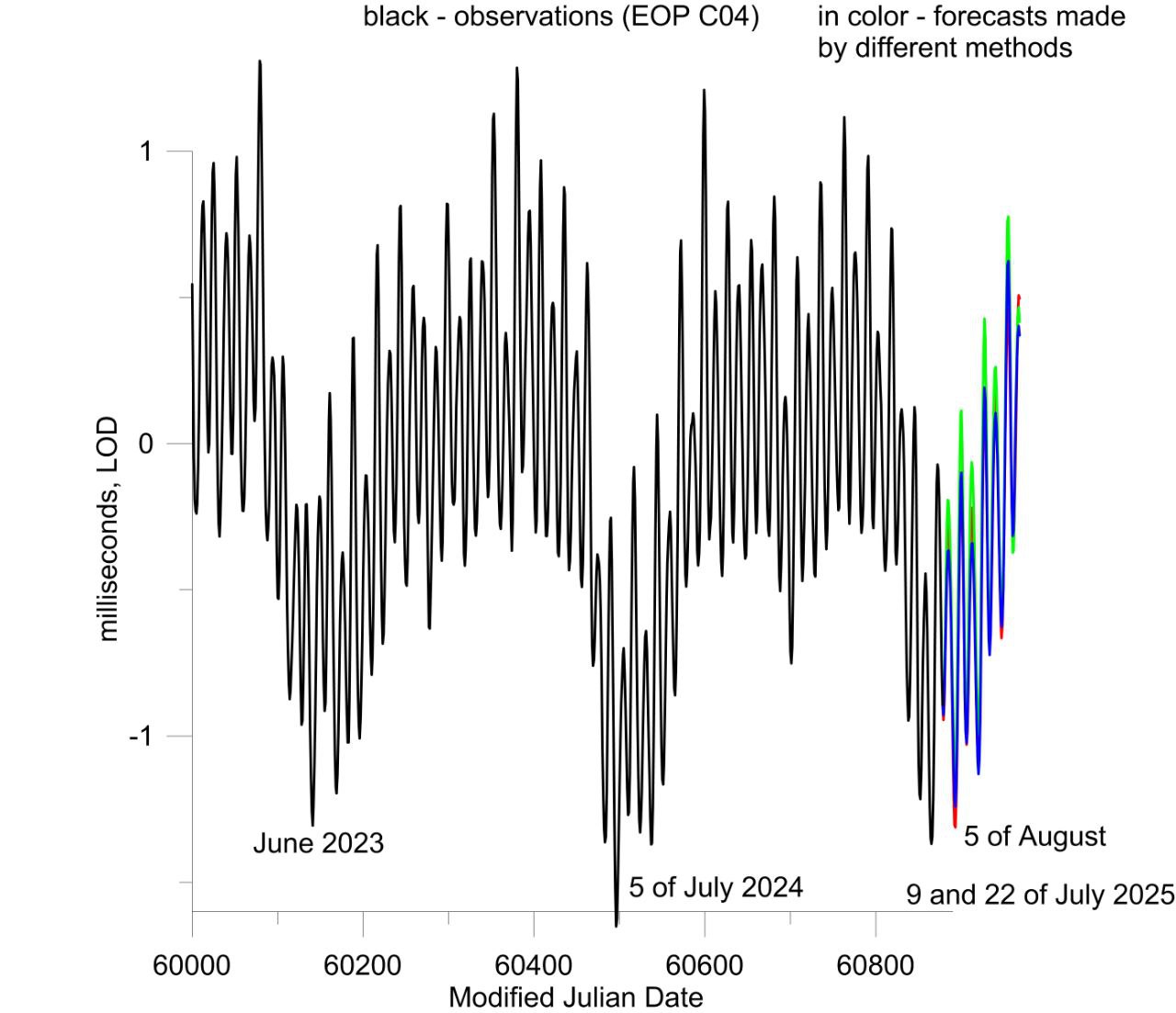Leap Second: How Chinese Dam Affects Planet Rotation Speed

Researchers predict that this summer, the planet may once again approach its maximum rotation speed. The causes of this acceleration are not fully understood, and there is still no definitive scientific explanation. Leonid Zotov, Professor at the School of Applied Mathematics, MIEM HSE, notes that if, in the past, the so-called ‘leap second’ was added on New Year’s Eve, then for the first time in history, the question has arisen about whether it is time to subtract one.
Scientists estimate that Earth’s maximum rotation speed may occur on July 9, July 22, and August 5 of the year 2025. They expect that the maximum reduction in the length of the day could be 1.51 milliseconds.
Of course, for humans, millisecond-level differences in the length of day are undetectable. However, these fluctuations are crucial for satellite navigation, global time synchronization, and precise scientific measurements. This is why scientists monitor them in real-time and even adjust the UTC (Coordinated Universal Time) atomic time scale to accommodate them.
‘In the past, on New Year’s Eve, a so-called “leap second” was always added when the need arose. Now, due to the acceleration of Earth’s rotation, there has been a question about whether it is time to subtract one. This may be the first time in history,’ explained Leonid Zotov, Professor at the School of Applied Mathematics, MIEM HSE.
Recently, Earth has started rotating faster. The reasons for this acceleration are still not fully understood. There are many theories: it could be related to the behaviour of the Earth’s core, atmospheric and ocean currents, or even the characteristics of the Moon’s orbit. However, there is no definitive scientific explanation for this phenomenon yet.
At that, some scientists believe that Earth's rotation can both speed up and slow down due to human activity. Recently, there has been news in the media and on social networks about how the Chinese Three Gorges Dam has slowed down Earth's rotation, causing an increase in the length of the day. According to calculations by Dr. Benjamin Fong Chao from the Shandong University of Science and Technology in Qingdao, 40 cubic kilometres of water from the Three Gorges Dam slightly changed Earth's moment of inertia. This has caused the day to lengthen by 0.06 microseconds and the axis of rotation to shift by two centimetres, according to calculations.
According to Leonid Zotov, this is possible, but such small changes are not yet detectable by modern instruments. Even though we are talking about the melting of glaciers in Greenland (270 gigatonnes per year) and Antarctica (150 gigatonnes per year), which leads to an increase in world ocean levels by several millimetres per year, if it could slow down Earth's rotation, these changes are still within the limits of current measurement accuracy. Additionally, there are natural processes that can accelerate Earth's rotation. For example, the level of the Caspian Sea has been steadily declining by about 10 centimetres annually since the early 2000s. This decrease in water level is similar to the amount of water held by the largest Chinese dam. However, while this water has accumulated in a dam once, it has been decreasing in the Caspian for more than two decades.

If we assume that this water evaporates and does not return to the same latitude, then Earth's rotation really accelerates. The effect of the shallowing of the Caspian Sea is stronger than that of the dam and is counter-directional, meaning it accelerates the rotation of Earth. The reasons for the decrease in water levels in the Caspian Sea are still unknown. Scientists are exploring several possible causes, including a reduction in the flow of the Volga River, increased evaporation, tectonic activity, and subsidence of the sea floor. They are also actively studying atmospheric, climatic, and geological factors, but have not yet reached any definitive conclusions. However, the observed increase in Earth’s rotational speed is too sinificant to be explained only by the shrinking of the Caspian Sea or other surface processes. Since 2020, scientists have recorded unprecedented values, indicating that Earth is rotating faster than at any time since accurate measurements started in the 1950s. The shortest day in history was recorded on July 5, 2024. It was 1.66 milliseconds shorter than the usual length of a day.
‘Most likely, the processes occurring inside the planet, such as the complex movement of the core, are likely responsible for this unusual event. However, oceanic and atmospheric models are not able to fully explain this sharp acceleration. Scientists continue to investigate the phenomenon in order to better understand it,’ says Leonid Zotov.
See also:
Physicists Propose New Mechanism to Enhance Superconductivity with 'Quantum Glue'
A team of researchers, including scientists from HSE MIEM, has demonstrated that defects in a material can enhance, rather than hinder, superconductivity. This occurs through interaction between defective and cleaner regions, which creates a 'quantum glue'—a uniform component that binds distinct superconducting regions into a single network. Calculations confirm that this mechanism could aid in developing superconductors that operate at higher temperatures. The study has been published in Communications Physics.
Neural Network Trained to Predict Crises in Russian Stock Market
Economists from HSE University have developed a neural network model that can predict the onset of a short-term stock market crisis with over 83% accuracy, one day in advance. The model performs well even on complex, imbalanced data and incorporates not only economic indicators but also investor sentiment. The paper by Tamara Teplova, Maksim Fayzulin, and Aleksei Kurkin from the Centre for Financial Research and Data Analytics at the HSE Faculty of Economic Sciences has been published in Socio-Economic Planning Sciences.
Larger Groups of Students Use AI More Effectively in Learning
Researchers at the Institute of Education and the Faculty of Economic Sciences at HSE University have studied what factors determine the success of student group projects when they are completed with the help of artificial intelligence (AI). Their findings suggest that, in addition to the knowledge level of the team members, the size of the group also plays a significant role—the larger it is, the more efficient the process becomes. The study was published in Innovations in Education and Teaching International.
New Models for Studying Diseases: From Petri Dishes to Organs-on-a-Chip
Biologists from HSE University, in collaboration with researchers from the Kulakov National Medical Research Centre for Obstetrics, Gynecology, and Perinatology, have used advanced microfluidic technologies to study preeclampsia—one of the most dangerous pregnancy complications, posing serious risks to the life and health of both mother and child. In a paper published in BioChip Journal, the researchers review modern cellular models—including advanced placenta-on-a-chip technologies—that offer deeper insights into the mechanisms of the disorder and support the development of effective treatments.
Using Two Cryptocurrencies Enhances Volatility Forecasting
Researchers from the HSE Faculty of Economic Sciences have found that Bitcoin price volatility can be effectively predicted using Ethereum, the second-most popular cryptocurrency. Incorporating Ethereum into a predictive model reduces the forecast error to 23%, outperforming neural networks and other complex algorithms. The article has been published in Applied Econometrics.
Administrative Staff Are Crucial to University Efficiency—But Only in Teaching-Oriented Institutions
An international team of researchers, including scholars from HSE University, has analysed how the number of non-academic staff affects a university’s performance. The study found that the outcome depends on the institution’s profile: in research universities, the share of administrative and support staff has no effect on efficiency, whereas in teaching-oriented universities, there is a positive correlation. The findings have been published in Applied Economics.
Physicists at HSE University Reveal How Vortices Behave in Two-Dimensional Turbulence
Researchers from the Landau Institute for Theoretical Physics of the Russian Academy of Sciences and the HSE University's Faculty of Physics have discovered how external forces affect the behaviour of turbulent flows. The scientists showed that even a small external torque can stabilise the system and extend the lifetime of large vortices. These findings may improve the accuracy of models of atmospheric and oceanic circulation. The paper has been published in Physics of Fluids.
Solvent Instead of Toxic Reagents: Chemists Develop Environmentally Friendly Method for Synthesising Aniline Derivatives
An international team of researchers, including chemists from HSE University and the A.N. Nesmeyanov Institute of Organoelement Compounds of the Russian Academy of Sciences (INEOS RAS), has developed a new method for synthesising aniline derivatives—compounds widely used in the production of medicines, dyes, and electronic materials. Instead of relying on toxic and expensive reagents, they proposed using tetrahydrofuran, which can be derived from renewable raw materials. The reaction was carried out in the presence of readily available cobalt salts and syngas. This approach reduces hazardous waste and simplifies the production process, making it more environmentally friendly. The study has been published in ChemSusChem.
How Colour Affects Pricing: Why Art Collectors Pay More for Blue
Economists from HSE University, St Petersburg State University, and the University of Florida have found which colours in abstract paintings increase their market value. An analysis of thousands of canvases sold at auctions revealed that buyers place a higher value on blue and favour bright, saturated palettes, while showing less appreciation for traditional colour schemes. The article has been published in Information Systems Frontiers.
New Method for Describing Graphene Simplifies Analysis of Nanomaterials
An international team, including scientists from HSE University, has proposed a new mathematical method to analyse the structure of graphene. The scientists demonstrated that the characteristics of a graphene lattice can be represented using a three-step random walk model of a particle. This approach allows the lattice to be described more quickly and without cumbersome calculations. The study has been published in Journal of Physics A: Mathematical and Theoretical.



